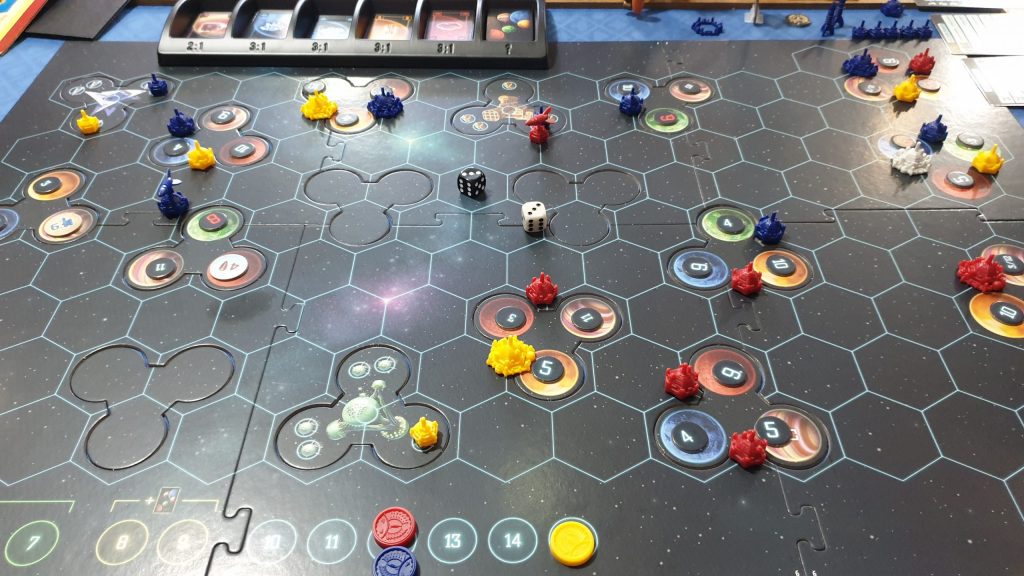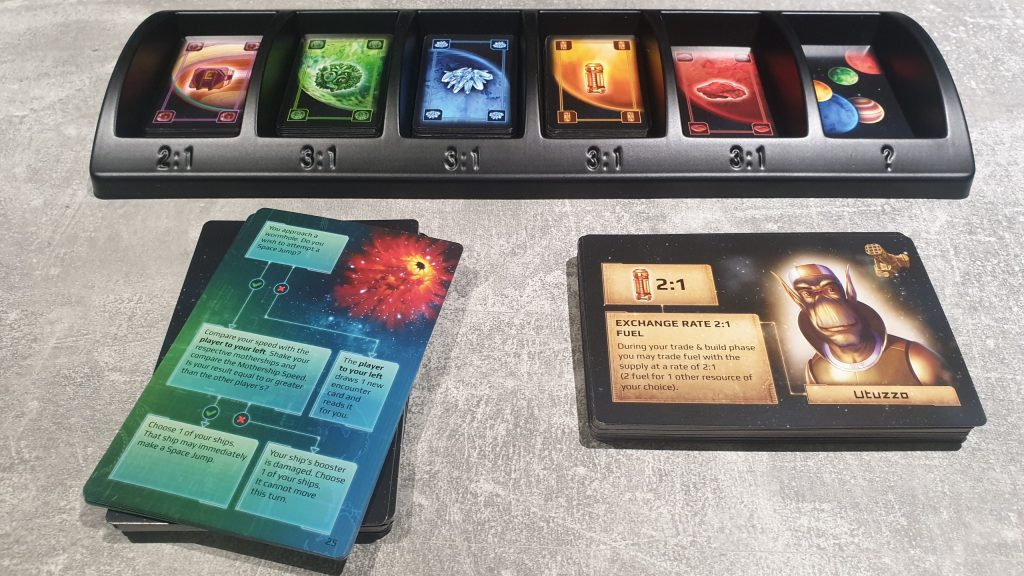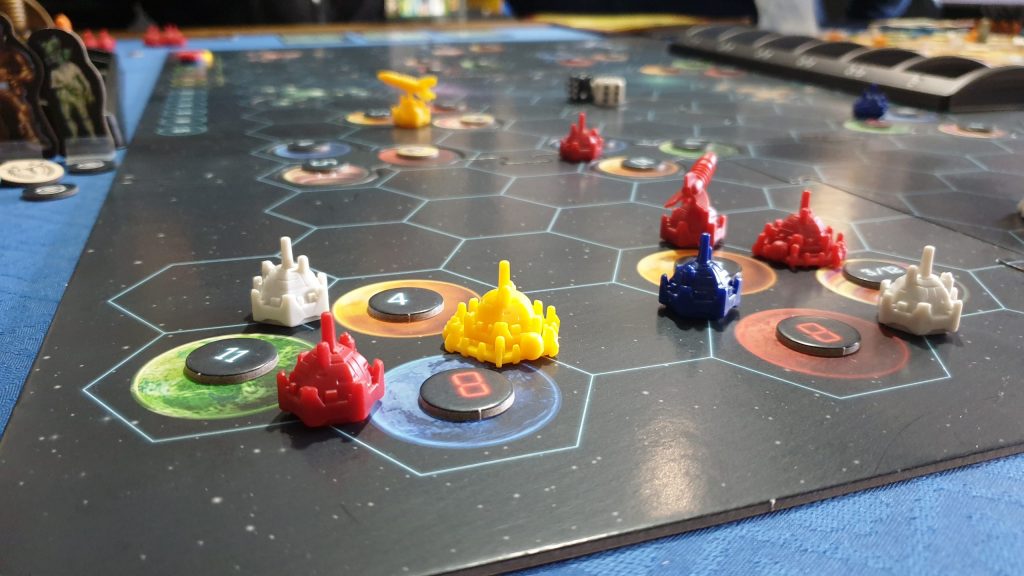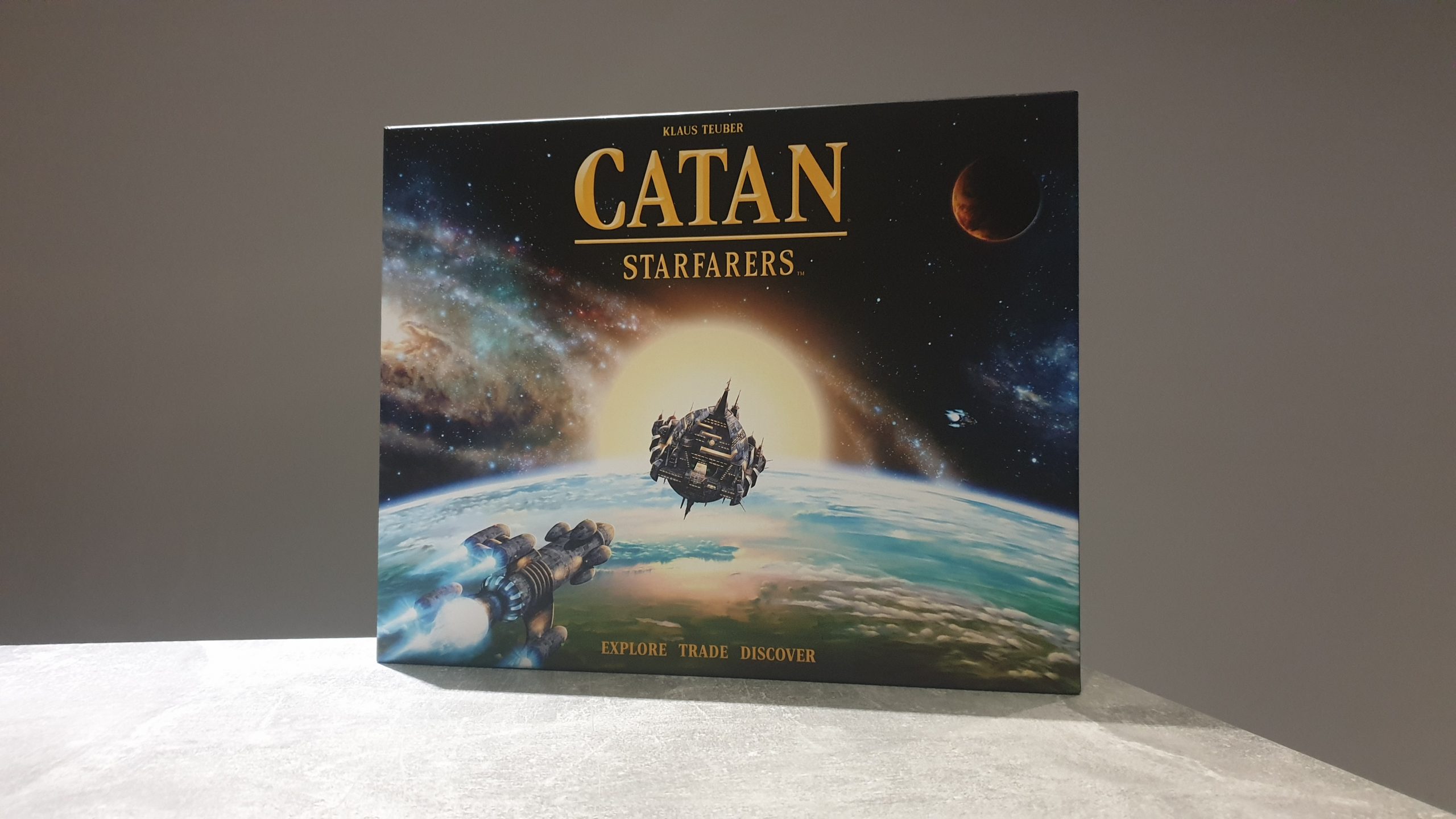Catan Starfarers is the brand new reimplementation of the 1999 space exploration title The Starfarers of Catan. Published by Catan Studio and KOSMOS, this space themed exploration and trading game was designed by Klaus Teuber, and features artwork from Michaela Kienle and Franz Vohwinkel. The game sees 3 – 4 players settle across the galaxy, encounter aliens and dastardly pirates – all in around 2 hours. However, does the introduction of rockets make the Catan experience out of this world? Let’s find out!
Straight from the offing Catan Starfarers offers gamers a choice to make their experience unique from one game to the next, with different setup options. With randomised or explore variants possible, the easiest is a beginners default layout of planets and outposts – which is listed clearly in the main rulebook. While the starting planets are printed on the board, those out in the galaxy printed on tri-planet tiles that fill gaps in the board.
Each player is going to take a large mothership, which is used throughout the game for checks. Picking a colour they also take all the associated player pieces, from space ports to ships. Each player starts with 2 colonies, 1 spaceport and a colony ship on the board. Placements are again dictated by the instructions if using the beginner set up. Like with the base (Settlers of) Catan experience each colony or spaceport sits in an intersection, this time between 2 planets. Each planet then has a type (colour) and a number.
While the basic gameplay is similar to Catan, there are some important additions and differences in Starfarers. A players turn still starts with rolling two dice, combining the values and triggering production on planets of that number. This can see anyone, not just the active player, gain resources – the first stage of keeping everyone constantly involved in the game. The active player then gains a bonus depending on what section of the score track they are on, seeing cards drawn from a special shuffled resource pile.

If a 7 is rolled a robber of sorts enters play, with no planets activated. All players with more than 7 cards must discard half rounded down – stopping the ability to always hoard cards. Next, the active player steals a card from one player: before all other players gain a random resource card.
Once the dice elements are resolved the active player is able to trade and build. Only trades with the active player are allowed, though the active player can also trade in sets of cards at a 3 or 2:1 cost with the bank. At this stage, players can also build colony or trade ships, upgrade a colony to a spaceport or upgrade their mothership. Building and trading is one phase so can be done in any order as many times as the active player wishes.
In base Catan the player’s turn would be over but this is where exploration comes in. If the player doesn’t have any ships in play this phase is skipped, otherwise it is time for the player to shake their mothership. Each mothership has 2 yellow, 1 red, one blue and 1 black balls inside them. From shaking two balls will fall down into the slot. If one is black an encounter occurs, before a movement can be performed, of 3 plus the number of boosters the players mothership has. If neither ball is black then the colour represents the distance provided, again plus boosters.
All of your ships can move up to the indicated distance. This is how player spread out across the galaxy. Sending a colony ship to a group of new planets unveils their number tokens, and players can choose to setup a colony between two of the three planets. The other ship type, the trade ship, sees players set up lucrative deals with aliens. On top of the player with the most trade posts in an alien system earning 2 points, per trade station players gain a special ability from the aliens. These range from free boosters on your mothership to earning additional food when it is produced.

This isn’t the only way players will come across things out in space. Those black ball encounters can see pirates, princes and more meeting players. Each poses a question or two to the player to answer, with an outcome determined by how you answer, and sometimes another shake of your mothership. Encounters are the main way that point tokens, which come in halves, come into play – though sometimes getting the worst result at an encounter sees these lost.
The game continues with players taking turns until one player reach 15 points. With alien tokens and point tokens able to be lost it isn’t always a direct march to victory. As players get close others will inevitably stop trading with them, making it harder to obtain what is needed. On top of this, the leader often has a target on their back: with players purposely trying to send trade ships to gain more favour with aliens to see the points lost.
The additional resources players gain on their turn is an obvious catch up mechanic. The lower you are on the tracker the more cards you gain. However, this also allows the game to be kickstarted, with a flood of additional resources consistently being added into circulation at the offset of the game. This cuts out a fair number of turns of merely collecting resources, allowing the game to get going straight away. This was noticed during the first game and from then on players tried to maximise the benefits before moving up the score track.
For those brand new to the Catan franchise there will be more to learn. This pushes it outside of a go to entry game for many, with increased rule caveats and placement impact compared to the original. It is far from a complicated weighty game, more of a Catan 1.5. Once a player has played Catan they’ll easily be able to jump across to Catan Starfarers. Aside from different names and costs, the way resources are earnt and spent are almost identical. The moving around the map is different but if someone understands the basic gameplay they’ll have no issue moving a ship X number of spaces.

The additional choices along the way add little to no weight to the experience but allow user driven decisions to impact play. Building boosters can negate low coloured balls when shaking for movement. Building weapons helps against pirates, including taking out located pirate bases. The way each encounter plays out is up to the individual player, even if when they appear is random. You might not want to annoy a Prince nor offer a merchant too much. Nothing is the key to victory, but each can open up opportunities.
Catan Starfarers is larger and more eye catching than the original, even with the vibrant colour palette mostly being replaced with dark space. The planets and the player pieces add colour while the size of the board sells the scale of the galaxy. The player pieces are all extremely easy to tell apart from each other. Initially, there was concerned about the trade and colony ships. Thankfully, the hexagon and pentagon shapes of the bases makes this a non issue. The encounter cards are of decent size, so the font isn’t micro in size. All in all the components are strong, and then you have the epic mothership in front of each player, ready to be shaken.
Catan Starfarers is a more daunting game to play than the standard (Settlers of) Catan. With encounters, aliens and more to worry about on top of the standard gameplay, it isn’t quite as new gamer friendly. Underpinning the experience though is the same Catan core, from the dice rolling to the way building up gives points. Using the original as a stepping stone to Starfarers, the experience could hook even more players, with the additional choices having an impact upon the outcome. It might take double the length of the standard Catan game but playing is well worth the extra time.
(Editor’s Note: Catan Starfarers was provided to us by Asmodee for the review. The game is currently available from local board game stores, find your local store here.)

